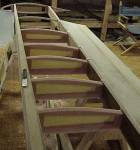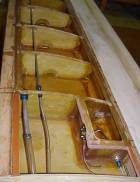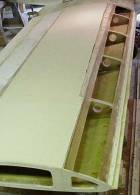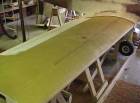The wings were originally "finished" several years ago. I decided that I could do a better job and had to do them over. The first effort was normal KR style contruction. My foam work was not as good as it could have been and I had to add more filler than I wanted. This method is slow to build, but very strong and accurate.
Click the small image for a larger version
 Everything in front of the rear spar was cut off and removed. Spar extensions were made from
2.5mm birch faces over foam. The partial plywood rib at the end of the wooden spars is
undersized by 3/8". This, together with an undersized false rib at the other end, becomes a
sanding form for the foam ribs that come next.
Everything in front of the rear spar was cut off and removed. Spar extensions were made from
2.5mm birch faces over foam. The partial plywood rib at the end of the wooden spars is
undersized by 3/8". This, together with an undersized false rib at the other end, becomes a
sanding form for the foam ribs that come next.
 1/4" inch thick Last-A-Foam ribs, with urethane added at the edges are sanded to size. Since
the sanding forms are 3/8" undersized, then the ribs are also 3/8" undersized.
1/4" inch thick Last-A-Foam ribs, with urethane added at the edges are sanded to size. Since
the sanding forms are 3/8" undersized, then the ribs are also 3/8" undersized.
The foam ribs were removed and covered with glass on one side. The urethane foam was then removed and the rib was glassed on the other side. This leaves a 1 inch wide flange around the edges of the rib. The glassed ribs were re-installed into postion.
The outer surface of the wing is made from 1/2" Last-A-Foam. What becomes the inside of the wing is glassed, trimmed to fit, and then floxed into place. With only one surface glassed, the foam can bend to fit the profile of the ribs.
Since the ribs are 3/8" undersized all around, the 1/2" foam protrudes about 1/8". When being finished, this is sanded down to the wing profile.
 The tank area is sealed, then a flange is added to the spars. This flange is formed by
glueing a piece of urethane foam in place, sanding to profile, and then glassing. Next, the
foam is removed which leaves a flange.
The tank area is sealed, then a flange is added to the spars. This flange is formed by
glueing a piece of urethane foam in place, sanding to profile, and then glassing. Next, the
foam is removed which leaves a flange.
In this photo, the large tube is the overflow from the fuselage header tank and the smaller tube is the vent line. Hoses are installed to help leak testing after the top is installed. The fuel level transmitter is located in a sump region. Two pieces of piano hinge form check valves. The fuel will flow into the sump, but not flow out. A finger strainer and low point drain are also in the sump.
The top surface was then glassed and floxed into place.
 The forward ribs are made from 1" urethane foam, covered with one ply of glass. Two undersized
false ribs were attached to the front of the spar and the glass/foam ribs were sanded to size.
The forward ribs are made from 1" urethane foam, covered with one ply of glass. Two undersized
false ribs were attached to the front of the spar and the glass/foam ribs were sanded to size.
 The bottom 1/2" Last-A-Foam was floxed in place and flanges added. Then the top surface was
installed.
The bottom 1/2" Last-A-Foam was floxed in place and flanges added. Then the top surface was
installed.
The foam was sanded to profile and glassed. The Last-A-Foam makes an almost perfect surface to work with. It does not sand as easily as the urethane foam, but it is not difficult to work with.
The surface was covered with peel ply. After cure, it left an almost perfect surface.
